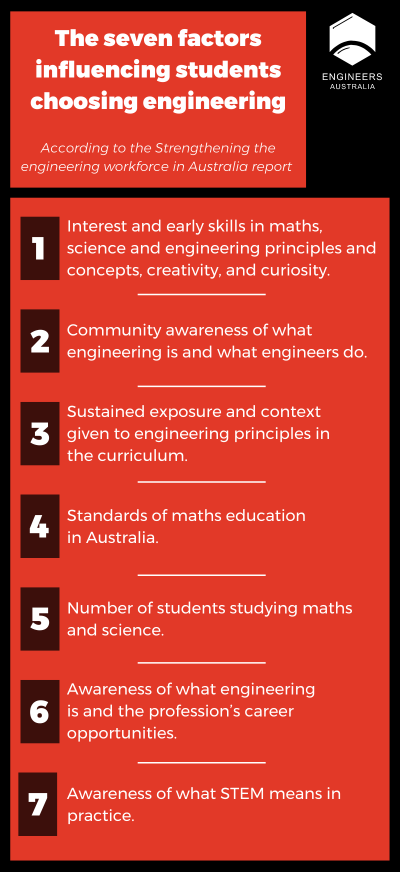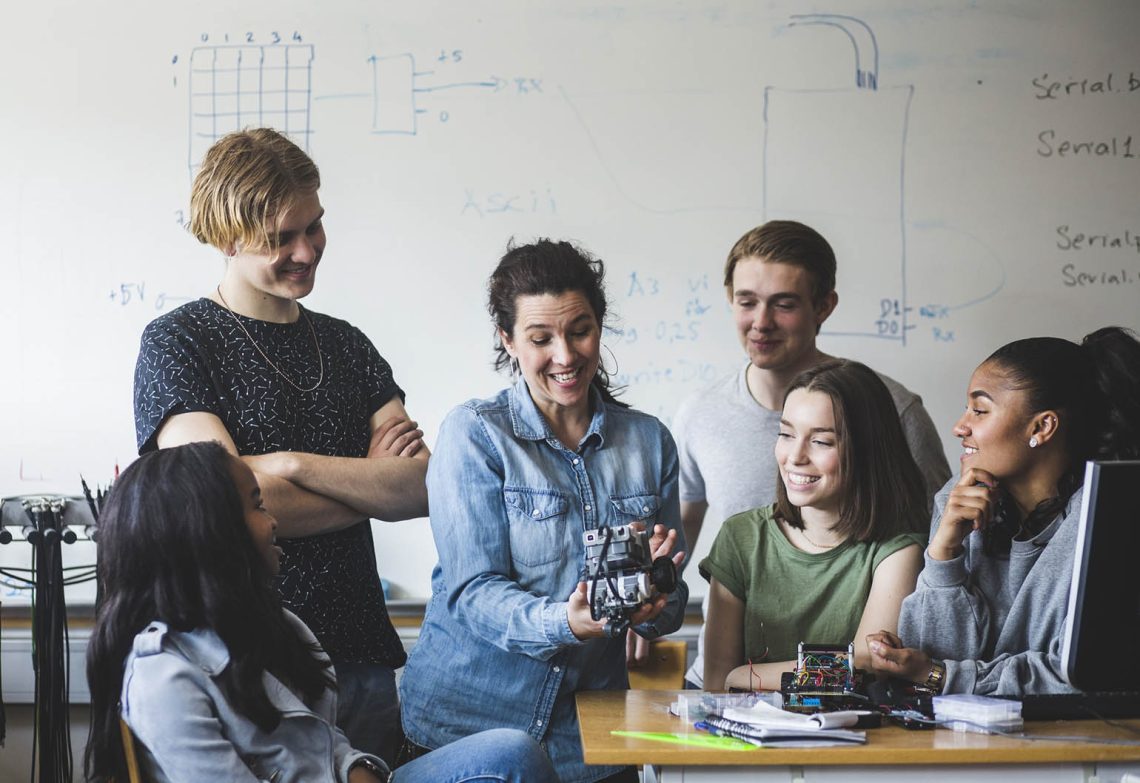Engineering vacancies are at a ten-year high and wages are growing. Engineering organisations are reporting extreme difficulties finding experienced engineers and future demand is expected to keep climbing. Australia’s worst ever engineering skills shortage may be on the horizon.
Demand for skilled workers is not limited to one sector of the economy, and with the exception of biomedical engineering, there is a shortage of skilled practitioners in every discipline of engineering.
“Our economy and society are more reliant on the engineering profession than ever before,” says Engineers Australia CEO Romilly Madew AO. “We need to ensure we have the engineers necessary to deliver on current government priorities and conceptualise the solutions needed to solve our society’s most complex problems.”
The Strengthening the engineering workforce in Australia report from Engineers Australia lays out five categories of factors that influence the engineering workforce:
- School education (primary and secondary)
- Engineering study (vocational and higher education)
- Retention in the engineering workforce
- Skilled migrant engineering workforce participation
- Demand forecasting
This article will concentrate on the first of those categories: School education.
Why do young Australians choose to study engineering?
The report identifies seven factors that influence students when choosing to pursue engineering as a course of study:

The development of an engineer begins early. In order to ensure that students are able to choose engineering as a career, teachers, parents and careers advisors need to be aware of the profession and corresponding career opportunities. This must be combined with promoting STEM subjects at the school level to ensure students are prepared to complete an engineering qualification and enter the profession.
STEM education in Australia
“We wanted to take a systems approach to this report,” says Jane MacMaster FIEAust CPEng, Engineers Australia’s Chief Engineer. “By that, I mean really understanding the influencing factors on our industry, and which of them are the most important. From there, we can focus on those that will have the most impact.”
“The influence on students really does begin with early childhood education,” she adds.
MacMaster, as part of her work for the Engineering for Australia task force, identified the characteristics of STEM programmes that work, and those that don’t. Unsurprisingly, the programmes that target early childhood and primary education are most effective at encouraging an engineering career.
“The research shows that girls in particular have made up their minds about what they’re good at quite early on, often in primary school,” says MacMaster. “So secondary education is too late.”
“It’s also too late because maths in particular is one of those things that if you fall behind, it’s much harder to catch up,” she adds.
Maths in Australian education
Professor Tim Marchant, Director of the Australian Mathematical Sciences Institute at the University of Melbourne, highlights the falling number of students taking mathematics at an advanced level.
“The number of students taking the highest level of maths has dropped to less than 10 per cent for the first time ever,” he says. The numbers for the intermediate level don’t look good either, with a drop from 20.5 per cent nationally to 17.6 per cent.
“Without that level of maths in Year 11 and 12, students aren’t going to be able to go on to engineering degrees,” says Marchant.
Another statistic cited by Marchant is not concerned with the numbers of students studying maths, but the performance of Australian students in the subject.
Every three years, the OECD tests 15-year-old students as part of their Programme for International Student Assessment (PISA). In 2003, Australian students ranked tenth in the world for mathematics. However, in 2018, Australia ranked 30th, with their performance dipping below the OECD world average for the first time.
“There just aren’t enough maths teachers,” says Marchant. “Around 40% of maths teachers in Year 7 to 9 are out-of-field teachers, meaning they don’t have maths qualifications.”
“It’s going to be more difficult for those teachers to inspire their students with what maths can do in the real world,” says MacMaster. “Maths can be quite abstract – if teachers can’t link mathematical ideas to the exciting ways they can be applied in the real world, then students can become bored.”
There are ways to mitigate this problem, says MacMaster.
“We need to provide more support to out-of-field maths teachers, and we need to incentivise more mathematically qualified people to become teachers,” she says.
Mid- or late-career engineers who are considering a career change can become particularly effective teachers, according to Marchant, but there has to be a change in how these professionals can qualify as teachers.
“Senior engineers have the mathematical background and they’ve got the stories to tell that make maths real and put it in context,” he says.
“They often tell me that they’d like to give something back by taking up teaching, but they are put off by the lengthy process of becoming a qualified teacher.”
The situation is worse in regional and rural areas, says Marchant.
“In some schools there may only be two or three students who want to study higher levels of mathematics, so we need ways to gather them together into a cohort,” he says.
A hybrid method of teaching might be the answer. Marchant suggests regional hubs could be established that cater to students who can attend in person or remotely.
“It would allow us to make better use of the teachers we have,” he says.
Adding engineering context to the curriculum
The Australian Curriculum, Assessment and Reporting Authority (ACARA) recently published the latest update to the Australian curriculum. MacMaster says that she was pleasantly surprised to see a lot of engineering concepts and principles in the Technology learning area.
“But the interesting thing was the word engineering wasn’t used,” she adds. “Teachers are using these engineering concepts and the students are learning them, but they’re not necessarily linking it to engineering.
“They’re learning how to make racing cars and water rockets and other exciting things, but they’re not being explicitly linked to engineering as a potential career, or even to the word engineering.”
Raising awareness in schools can start with simple solutions; MacMaster describes posters and other material that can be shared with schools that make the connection between their lessons and the engineering profession clearer.
Mentoring opportunities for engineers can also help spread the word in our schools. “Research shows us that school students prefer to hear from younger engineers,” says MacMaster.
Young engineers, or even undergraduates, can tick two boxes – they can offer maths tutoring to interested students, and also link those principles to engineering. MacMaster explains that many engineers she speaks to, when asked how they got interested in engineering, have an engineer in their lives already.
“We can make engineering stories real for people,” she says.
Awareness of the breadth of engineering in the wider community
While a world-class education system that promotes STEM education from an early age is clearly important, community awareness of engineering and its breadth is also vital, says MacMaster.
“A lot of politicians refer to STEM, or science, but what they’re actually talking about is engineering,” she says. “We need to make sure that everyone recognises the importance of the E in STEM.”
Encouraging more women into engineering
Not only is the overall number of young Australians choosing engineering declining, but we’re also not encouraging enough women to study the subject.
“We want girls to undertake STEM subjects, and attract them to engineering,” says Madew. “When you consider that only 16 per cent of engineering students are women, we really can do better.”
“90% of women in non-engineering fields never considered, or only briefly considered studying engineering,” adds MacMaster. “And only 7% of women who pursued other fields say they seriously considered studying engineering at all.”
The single most cited reason for this was because they didn’t know what engineering was or what engineers do.
So what do engineers do?
“People engage with the work of engineers every single day,” says MacMaster. “We wake up with technology and we engage with it every single second of the day. And yet we are just a little bit removed from the engineers who made that technology possible.”
“We don’t engage with engineers in the same way that we engage with doctors, lawyers, or teachers,” continues MacMaster.
Another reason for the lack of awareness of what engineering really means, says MacMaster, is that it’s such a broad profession. “There are so many kinds of engineers, that the idea of what an engineer ‘does’ is hard to pin down for many people,” she says.
“This is a question that I ask almost every engineer that I come across – what is it that engineers do? And the most common answer I hear is something about problem solving.
“But of course, doctors solve problems too, and so do lawyers and teachers. So I’m not convinced that that definition’s quite enough.
“The question we need to answer is how do we describe our profession to careers advisors, to teachers, to parents, to school students and the broader community.”
The answer, or at least part of the answer, is provided in the Strengthening the engineering workforce in Australia report. Engineers Australia has already begun its Engineering: Making Life Happen campaign, the aim of which is to raise the profile of engineers and highlight the pivotal work that they do.
So what’s next?
Engineers Australia has committed to the process of prioritising the initiatives outlined in the Strengthening the engineering workforce in Australia report, in collaboration with their stakeholders, and encouraging more students to consider engineering as a course of study, and ultimately as a career.
As MacMaster puts it, “young people are passionate about making the world a better place, and engineers have the potential to do that.”




It would be good if more engineers such as myself (retired) could visit secondary educational facilities to explain to students what advantages and possibilities Engineering can bring. It has given me the ability to think logically and practically and has opened doors to some of the biggest projects in Australia and overseas. My career was most rewarding in that I worked on a diverse variety of projects in Dubai, Philippines, England, Wales, Nigeria and some of the biggest and most diverse projects all over Australia. It is very much an opportunity to work with people in the community and to have a huge impact. I was swayed into engineering by a CRB engineer who presented to us at Hamilton Technical College and I never regretted making the decision. It is an exciting and challenging career.
Having taught electrical apprentices as an engineer my role was to ensure their math and physics were up to speed. I was confronted by a few students who had gaps in their math understanding, particularly algebra at the very basic level. I wonder if we should worry about the point in schooling that algebra is first introduced and whether there is a way to reinforce learning at that point.
This is an excellent article and working in career guidance I agree with your comments of the importance of increasing awareness of what engineers do and the career opportunities available.
By way of background I’m CEO of MyCareerMatch a leading provider of career application software to high schools and universities. We identify student strengths and match them to careers we recommend they consider. Discovering career options is positive and rewarding experience for teenagers and their parents.
In collaboration with CSIRO we created an app to encourage and attract students to careers in technology. Each year hundreds of thousands of students view their personalised tech career options. We created this for two reasons, to make students aware of the range tech careers and to explain what each does.
I’d welcome an opportunity to introduce our Engineering program to Engineers Australia. It’s being used by Study Australia to engage with international students.